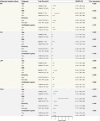Association between abdominal obesity indices and risk of cardiovascular events in Chinese populations with type 2 diabetes: a prospective cohort study
- PMID: 36320060
- PMCID: PMC9628026
- DOI: 10.1186/s12933-022-01670-x
Association between abdominal obesity indices and risk of cardiovascular events in Chinese populations with type 2 diabetes: a prospective cohort study
Abstract
Background: Waist circumference (WC), visceral adiposity index (VAI), lipid accumulation product (LAP), and Chinese visceral adiposity index (CVAI) are considered surrogate indicators of abdominal fat deposition, but the longitudinal association of these indices with cardiovascular (CV) events in adults with type 2 diabetes (T2D) remains unclear. Our study aimed to examine the associations between abdominal obesity indices and incident CV events among people with T2D and to compare their predictive performance in risk assessment.
Methods: The present study included 2328 individuals with T2D from the Xinjiang Multi-Ethnic Cohort. Multivariable Cox regression analyses were applied to assess the associations between abdominal obesity indices and CV events. Harrell's concordance statistic (C-statistic), net reclassification improvement (NRI) index, and integrated discrimination improvement (IDI) index were utilized to evaluate the predictive performance of each abdominal obesity index.
Results: At a median follow-up period of 59 months, 289 participants experienced CV events. After multivariable adjustment, each 1-SD increase in WC, VAI, LAP, and CVAI was associated with a higher risk of CV events in people with T2D, with adjusted hazard ratios (HRs) being 1.57 [95% CI (confidence interval): 1.39-1.78], 1.11 (95% CI 1.06-1.16), 1.46 (95% CI 1.36-1.57), and 1.78 (95% CI 1.57-2.01), respectively. In subgroup analyses, these positive associations appeared to be stronger among participants with body mass index (BMI) < 25 kg/m2 compared to overweight/obese participants. As for the predictive performance, CVAI had the largest C-statistic (0.700, 95% CI 0.672-0.728) compared to VAI, LAP, WC, and BMI (C-statistic: 0.535 to 0.670, all P for comparison < 0.05). When the abdominal obesity index was added to the basic risk model, the CVAI index also showed the greatest incremental risk stratification (C-statistic: 0.751 vs. 0.701, P < 0.001; IDI: 4.3%, P < 0.001; NRI: 26.6%, P < 0.001).
Conclusions: This study provided additional evidence that all abdominal obesity indices were associated with the risk of CV events and highlighted that CVAI might be a valuable abdominal obesity indicator for identifying the high risk of CV events in Chinese populations with T2D. These results suggest that proactive assessment of abdominal obesity could be helpful for the effective clinical management of the diabetic population.
Keywords: Abdominal obesity; Cardiovascular disease; Chinese visceral adiposity index; Lipid accumulation product; Type 2 diabetes; Visceral adiposity index.
© 2022. The Author(s).
Conflict of interest statement
The authors declare that they have no competing interests.
Figures



References
-
- Sun H, Saeedi P, Karuranga S, Pinkepank M, Ogurtsova K, Duncan BB, Stein C, Basit A, Chan JCN, Mbanya JC, et al. IDF diabetes Atlas: global, regional and country-level diabetes prevalence estimates for 2021 and projections for 2045. Diabetes Res Clin Pract. 2022;183:109119. doi: 10.1016/j.diabres.2021.109119. - DOI - PMC - PubMed
-
- Shah AD, Langenberg C, Rapsomaniki E, Denaxas S, Pujades-Rodriguez M, Gale CP, Deanfield J, Smeeth L, Timmis A, Hemingway H. Type 2 diabetes and incidence of cardiovascular diseases: a cohort study in 1.9 million people. Lancet Diabetes Endocrinol. 2015;3(2):105–13. doi: 10.1016/S2213-8587(14)70219-0. - DOI - PMC - PubMed
Publication types
MeSH terms
LinkOut - more resources
Full Text Sources
Medical
Research Materials

